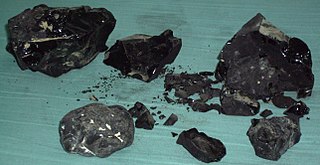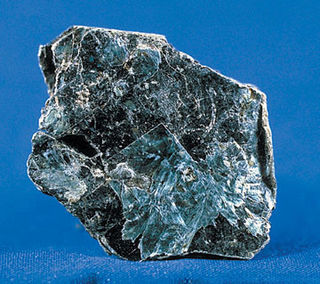Related Research Articles

Bitumen is an immensely viscous constituent of petroleum. Depending on its exact composition it can be a sticky, black liquid or an apparently solid mass that behaves as a liquid over very large time scales. In the U.S., the material is commonly referred to as asphalt. Whether found in natural deposits or refined from petroleum, the substance is classed as a pitch. Prior to the 20th century the term asphaltum was in general use. The word derives from the ancient Greek ἄσφαλτος ásphaltos, which referred to natural bitumen or pitch. The largest natural deposit of bitumen in the world, estimated to contain 10 million tons, is the Pitch Lake of southwest Trinidad.

Concrete is a composite material composed of aggregate bonded together with a fluid cement that cures over time. Concrete is the second-most-used substance in the world after water, and is the most widely used building material. Its usage worldwide, ton for ton, is twice that of steel, wood, plastics, and aluminium combined.

Vermiculite is a hydrous phyllosilicate mineral which undergoes significant expansion when heated. Exfoliation occurs when the mineral is heated sufficiently; commercial furnaces can routinely produce this effect. Vermiculite forms by the weathering or hydrothermal alteration of biotite or phlogopite. Large commercial vermiculite mines exist in the United States, Russia, South Africa, China, and Brazil.

A road surface or pavement is the durable surface material laid down on an area intended to sustain vehicular or foot traffic, such as a road or walkway. In the past, gravel road surfaces, macadam, hoggin, cobblestone and granite setts were extensively used, but these have mostly been replaced by asphalt or concrete laid on a compacted base course. Asphalt mixtures have been used in pavement construction since the beginning of the 20th century and are of two types: metalled (hard-surfaced) and unmetalled roads. Metalled roadways are made to sustain vehicular load and so are usually made on frequently used roads. Unmetalled roads, also known as gravel roads, are rough and can sustain less weight. Road surfaces are frequently marked to guide traffic.

Asphalt concrete is a composite material commonly used to surface roads, parking lots, airports, and the core of embankment dams. Asphalt mixtures have been used in pavement construction since the beginning of the twentieth century. It consists of mineral aggregate bound together with bitumen, laid in layers, and compacted.

Permeable paving surfaces are made of either a porous material that enables stormwater to flow through it or nonporous blocks spaced so that water can flow between the gaps. Permeable paving can also include a variety of surfacing techniques for roads, parking lots, and pedestrian walkways. Permeable pavement surfaces may be composed of; pervious concrete, porous asphalt, paving stones, or interlocking pavers. Unlike traditional impervious paving materials such as concrete and asphalt, permeable paving systems allow stormwater to percolate and infiltrate through the pavement and into the aggregate layers and/or soil below. In addition to reducing surface runoff, permeable paving systems can trap suspended solids, thereby filtering pollutants from stormwater.

Emery, or corundite, is a dark granular rock used to make an abrasive powder. It largely consists of corundum, mixed with other minerals such as the iron-bearing spinels, hercynite, and magnetite, and also rutile (titania). Industrial emery may contain a variety of other minerals and synthetic compounds such as magnesia, mullite, and silica.

Soil mechanics is a branch of soil physics and applied mechanics that describes the behavior of soils. It differs from fluid mechanics and solid mechanics in the sense that soils consist of a heterogeneous mixture of fluids and particles but soil may also contain organic solids and other matter. Along with rock mechanics, soil mechanics provides the theoretical basis for analysis in geotechnical engineering, a subdiscipline of civil engineering, and engineering geology, a subdiscipline of geology. Soil mechanics is used to analyze the deformations of and flow of fluids within natural and man-made structures that are supported on or made of soil, or structures that are buried in soils. Example applications are building and bridge foundations, retaining walls, dams, and buried pipeline systems. Principles of soil mechanics are also used in related disciplines such as geophysical engineering, coastal engineering, agricultural engineering, hydrology and soil physics.
Soil cement is a construction material, a mix of pulverized natural soil with small amount of portland cement and water, usually processed in a tumbler, compacted to high density. Hard, semi-rigid durable material is formed by hydration of the cement particles.

Chipseal is a pavement surface treatment that combines one or more layer(s) of asphalt with one or more layer(s) of fine aggregate. In the United States, chipseals are typically used on rural roads carrying lower traffic volumes, and the process is often referred to as asphaltic surface treatment. This type of surface has a variety of other names including tar-seal or tarseal, tar and chip, sprayed sealsurface dressing, or simply seal.

Construction aggregate, or simply aggregate, is a broad category of coarse- to medium-grained particulate material used in construction, including sand, gravel, crushed stone, slag, recycled concrete and geosynthetic aggregates. Aggregates are the most mined materials in the world. Aggregates are a component of composite materials such as concrete and asphalt; the aggregate serves as reinforcement to add strength to the overall composite material. Due to the relatively high hydraulic conductivity value as compared to most soils, aggregates are widely used in drainage applications such as foundation and French drains, septic drain fields, retaining wall drains, and roadside edge drains. Aggregates are also used as base material under foundations, roads, and railroads. In other words, aggregates are used as a stable foundation or road/rail base with predictable, uniform properties, or as a low-cost extender that binds with more expensive cement or asphalt to form concrete. Although most kinds of aggregate require a form of binding agent, there are types of self-binding aggregate which do not require any form of binding agent.

Stone mastic asphalt (SMA), also called stone-matrix asphalt, was developed in Germany in the 1960s with the first SMA pavements being placed in 1968 near Kiel. It provides a deformation-resistant, durable surfacing material, suitable for heavily trafficked roads. SMA has found use in Europe, Australia, the United States, and Canada as a durable asphalt surfacing option for residential streets and highways. SMA has a high coarse aggregate content that interlocks to form a stone skeleton that resists permanent deformation. The stone skeleton is filled with a mastic of bitumen and filler to which fibres are added to provide adequate stability of bitumen and to prevent drainage of binder during transport and placement. Typical SMA composition consists of 70−80% coarse aggregate, 8−12% filler, 6.0−7.0% binder, and 0.3 per cent fibre.

Crushed stone or angular rock is a form of construction aggregate, typically produced by mining a suitable rock deposit and breaking the removed rock down to the desired size using crushers. It is distinct from naturally occurring gravel, which is produced by natural processes of weathering and erosion and typically has a more rounded shape.
Asphalt most often refers to:

Bituminous waterproofing systems are designed to protect residential and commercial buildings. Bitumen is a material made up of organic liquids that are highly sticky, viscous, and waterproof. Systems incorporating bituminous-based substrates are sometimes used to construct roofs, in the form of "roofing felt" or "roll roofing" products.
Porosity or void fraction is a measure of the void spaces in a material, and is a fraction of the volume of voids over the total volume, between 0 and 1, or as a percentage between 0% and 100%. Strictly speaking, some tests measure the "accessible void", the total amount of void space accessible from the surface.

The Mineral Products Association (MPA) is the United Kingdom trade association for the aggregates, asphalt, cement, concrete, dimension stone, lime, mortar, and silica sand industries.

Concrete is produced in a variety of compositions, finishes and performance characteristics to meet a wide range of needs.
The Refined Bitumen Association is the trade association for UK bitumen companies.

Nanoconcrete is a form of concrete that contains Portland cement particles that are no greater than 100 μm and particles of silica no greater than 500 μm, which fill voids that would otherwise occur in normal concrete, thereby substantially increasing the material's strength. It is also a product of high-energy mixing (HEM) of conventional cement, sand and water which is a bottom-up approach of nano technology.
References
- Asphalt Mixture Volumetrics.